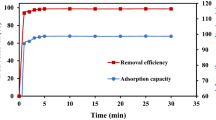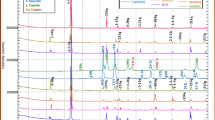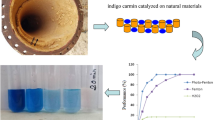Abstract
Two new heterogeneous catalysts (Cu-sand) have been synthesized by supporting copper on the surface of natural sand using two defined methods such as chemical vapor deposition (CVD) and dry evaporation (DE). The Cu-sand catalysts were characterized by several techniques. SEM-EDX analysis indicated that 13.86 wt% of copper species were dispersed on the surface of Cu-sand (CVD) catalyst whereas 11 wt% were agglomerated on the Cu-sand (DE) surface. The presence of copper species was more noticeable in the XRD pattern for the Cu-sand (CVD) catalyst. The catalytic performance of the prepared catalysts was evaluated in the Fenton-like oxidation of Alizarin red S dye (ARS). The reactivity and stability of the two catalysts were differentiated by studying the influence of the supported amount of copper, activity of leachate and the reuse of catalyst on the conversion of initial concentration of ARS. ARS oxidation has been investigated under various experimental conditions. The best ARS conversion rate was about 95% when using Cu-sand (CVD) catalyst in optimal conditions: [H2O2]0 = 10 mmol/L, temperature = 40 °C and the addition of H2O2 in two stages (0 min and 20 min of treatment). CVD method makes it possible to prepare an efficient and stable catalyst.


















Similar content being viewed by others
References
Di Daniele T, Santo Fabio C, Michele T, Gaspare V (2019) Treatment of high strength industrial wastewater with membrane bioreactors for water reuse: Effect of pre-treatment with aerobic granular sludge on system performance and fouling tendency. J Water Process Eng 31:100859
Sainan S, Tingting J, Yujin L, Jiaxiu S, Yuanyuan Z, Dong A (2020) Characteristics of organic pollutants in source water and purification evaluations in drinking water treatment plants. Sci Total Environ 733:139277
Dong X, Lai Yoke L, Fang Yee L, Zhiyang L, Hao Z, Say Leong O, Jiangyong H (2020) Water treatment residual: a critical review of its applications on pollutant removal from stormwater runoff and future perspectives. J Environ Manage 259:109649
Aggeliki T, Emmanouil-Nikolaos P, Zisis V, Athina K, Katerina K, Euphemia PM (2019) Assessment and management of pesticide pollution at a river basin level part I: Aquatic ecotoxicological quality indices. Sci Total Environ 653:1597–1611
Hua D, Ren W, Wenya L, Lingling H, BowenYa’nan LD, Huahong S (2020) Microplastic pollution in water and sediment in a textile industrial area. Environ Pollut 258:113658
Swarnkumar R, Jabez OW (2020) Heavy metal determination and aquatic toxicity evaluation of textile dyes and effluents using Artemia salina. Biocatal Agric Biotechnol 258:113658
Hualing C, Jieying L, Xun-an N, Xiaojun L, Yang L (2020) Algal toxicity induced by effluents from textile-dyeing wastewater treatment plants. J Environ Sci 91:199–208
Wonyong C (2006) Pure and modified TiO2 photocatalysts and their environmental applications. Catal Surv from Asia 10:16–28
Houria G, Oualid H (2009) Intensification of sonochemical decolorization of anthraquinonic dye Acid Blue 25 using carbon tetrachloride. Ultrason Sonochem 16:455–461
Martinez-Huitle CA, Rodrigo MA, Sires I, Scialdone O (2015) Single and coupled electrochemical processes and reactors for the abatement of organic water pollutants: a critical review. Chem Rev 115:13362–13407
Gong C, Chen F, Yang Q, Luo K, Yao FB, Wang SN, Wang XL, Wu JW, Li XM, Wang DB, Zeng GM (2017) Heterogeneous activation of peroxymonosulfate by Fe-Co layered doubled hydroxide for efficient catalytic degradation of Rhoadmine B. Chem Eng J 321:222–232
Mélinda G, Jennifer D, Marc P, Carolina GM, Thomas G, Carmen MN (2020) Comparative efficiency of three advanced oxidation processes for thiosalts oxidation in mine-impacted water. Miner Eng 152:106349
Jong-Hwan P, Jim JW, Negar T, Ronald DD (2019) Removal of Eriochrome Black T by sulfate radical generated from Fe-impregnated biochar/persulfate in Fenton-like reaction. J Ind Eng Chem 71:201–209
Runhua W, Yajuan H, Gang C (2020) Heterogeneous oxidation of isoprene SOA and toluene SOA tracers by ozone. Chemosphere 249:126258
Marcelina R, Małgorzata R, Andrzej K, Paweł M, Aneta Ś, Urbano D, Antonio EP, Wojciech M, Lucjan C (2020) Catalytic oxidation of organic sulfides by H2O2 in the presence of titanosilicate zeolites. Micropor. Mesopor Mat 302:110219
Guangrui W, Ying L, Jinwen Y, Zifeng L, Xiaojiao Y (2020) Electrochemical oxidation of methyl orange by a Magnéli phase Ti4O7 anode. Chemosphere 241:125084
Pankaj SS, Parag RG (2020) Ultrasound assisted oxidative deep-desulfurization of dimethyl disulphide from turpentine. Ultrason Sonochem 63:104925
Abdessalem O, Wiem H, Mourad B (2020) Photo-Fenton oxidation and mineralization of methyl orange using Fe-sand as effective heterogeneous catalyst. J Photochem Photobiol A 393:112444
Abdessalem O, Mourad B, Feten B (2015) Industrial application of photocatalysts prepared by hydrothermal and sol-gel methods. J Ind Eng Chem 21:356–362
Abdessalem O, Mourad B (2019) Influence of the origin of carbon support on the structure and properties of TiO2 nanoparticles prepared by dip coating method. Arab J Chem 12:2926–2936
Jae Sung L (2005) Photocatalytic water splitting under visible light with particulate semiconductor catalysts. Catal Surv from Asia 9:217–227
Guoquan Z, Fenglin Y, Lifen L (2009) Comparative study of Fe2+/H2O2 and Fe3+/H2O2 electro-oxidation systems in the degradation of amaranth using anthraquinone/polypyrrole composite film modified graphite cathode. J Electroanal Chem 632:154–161
Ziembowicz S, Kida M, Koszelnik P (2019) Reservoir bottom sediments as heterogeneous catalysts for effective degradation of a selected endocrine-disrupting chemical via a Fenton-like process. J Water Process Eng 32:100950
Filipa D, Maldonado-Hódar FJ, Pérez-Cadenas AF, Madeira Luis M (2009) Fenton-like degradation of azo-dye Orange II catalyzed by transition metals on carbon aerogels. Appl Catal B-Environ 85:139–147
Kijung K, Dong KY, Ungyu P (2017) CuO embedded silica nanoparticles for tungsten oxidation via a heterogeneous Fenton-like reaction. Microelectron Eng 183:58–63
Bel Hadjltaief H, Costa PD, Beaunier P, Gálvez ME, Benzina M (2014) Fe-clay-plate as a heterogeneous catalyst in photo-Fenton oxidation of phenol as probe molecule for water treatment. Appl Clay Sci 91:46–54
Abdessalem O, Lambert SD, Geens J, F eten B, Mourad B, (2014) Synthesis, surface characterization and photocatalytic activity of TiO2 supported on almond shell activated carbon. J Mater Sci Technol 30:894–902
Abdessalem O, Mourad B (2014) Almond shell activated carbon: adsorbent and catalytic support in the phenol degradation. Environ Monit Assess 186:3875–3890
Boujelben N, Bouzid J, Elouear Z (2009) Adsorption of nickel and copper onto natural iron oxide-coated sand from aqueous solutions: study in single and binary systems. J Hazard Mater 163:376–382
Sdiri A, Higashi T, Bouaziz S, Benzina M (2014) Synthesis and characterization of silica gel from siliceous sands of southern Tunisia. Arab J Chem 7:486–493
Hmani E, Chaabane ES, Youssef S, Ridha A (2009) Electrochemical degradation of waters containing O-Toluidine on PbO2 and BDD anodes. J Hazard Mater 170:928–933
Collectif AFNOR. La qualité de l’eau, tome II, Analyses organoleptiques. Mesures physico-chimiques. Paramètres globaux. Composés organiques, NFT 90-102. Groupe Eyrolles S.A AFNOR 1999
Trabelsi W, Benzina M, Bouaziz S (2009) Physico-chemical characterisation of the Douiret sand (Southern Tunisia): valorisation for the production of Silica Gel. Phys Procedia 2:1461–1467
Frank LYL, Xijun H (2003) A new system design for the preparation of copper/activated carbon catalyst by metal-organic chemical vapor deposition method. Chem Eng Sci 58:687–695
Zhiwei H, Fang C, Jingjing X, Jianliang Z, Jing C, Chungu X (2012) Cu/SiO2 catalysts prepared by hom- and heterogeneous deposition–precipitation methods: Texture, structure, and catalytic performance in the hydrogenolysis of glycerol to 1,2-propanediol. Catal Today 183:42–51
Chang-Mao H (2009) Activity of Cu-activated carbon fiber catalyst in wet oxidation of ammonia solution. J Hazard Mater 166:1314–1320
Biswajoy B, Subrata K, Sumit KD, Suman B, Debasis R, Tapas KM, Sukhen D, Papiya N (2013) In situ synthesis and antibacterial activity of copper nanoparticle loaded natural montmorillonite clay based on contact inhibition and ion release. Colloids Surf. B 108:358–365
Chaudhry SA, Khan TA (2017) Equilibrium, kinetic and thermodynamic studies of Cr (VI) adsorption from aqueous solution onto manganese oxide coated sand grain (MOCSG). J Mol Liq 236:320–330
Elliot LB, Thomas W, Patrick JM, Keith R, Alex CH, Silvia I, Samantha KC, Gregory AC, Stewart FP (2015) Structure and spectroscopy of CuH prepared via borohydride reduction. Acta Cryst B 71:608–612
Rasmita N, Farida AA, Dilip KM, Debes R, Aswal VK, Susanta KS, Binita N (2020) Fabrication of CuO nanoparticle: an efficient catalyst utilized for sensing and degradation of phenol. J Mater Res Technol 9:11045–11059
Mengchao S, Zetao C, Saba F, Thor F, Xueli M, Yin X, Chengtie W (2016) Copper-doped mesoporous silica nanospheres, a promising immunomodulatory agent for inducing osteogenesis. Acta Biomater 30:334–344
Nayak NB, Nayak BB (2016) Temperature-mediated phase transformation, pore geometry and pore hysteresis transformation of borohydride derived in-born porous zirconium hydroxide nanopowders. Sci Rep 6
Lai L, Lili Z, Chun H (2015) Enhanced Fenton-like degradation of pharmaceuticals over framework copper species in copper-doped mesoporous silica microspheres. Chem Eng J 274:298–306
Fethi K, Yan L, Rawan A, Awadh A (2015) Effect of acid activation of Saudi local clay mineral on removal properties of basic blue 41 from an aqueous solution. Appl Clay Sci 116:23–30
Carvalho MCNAD, Passos FB, Schmal M (2000) The behavior of Cu/ZSM-5 in the oxide and reduced form in the presence of NO and methanol. Appl Catal A-Gen 193:265–276
Muthusamy PP, Sekar K, Rajamanickam M, Adam FL, Anand R (2017) Fenton-like degradation of Bisphenol A catalyzed by mesoporous Cu/TUD-1. Appl Surf Sci 393:67–73
Mendes FMT, Schmal M (1997) The cyclohexanol dehydrogenation on Rh-Cu/A12O3 catalysts Part 1. Characterization of the catalyst. Appl Catal A-Gen 151:393–408
Lovjeet S, Pawan R, Shri C (2016) Cu-impregnated zeolite Y as highly active and stable heterogeneous Fenton-like catalyst for degradation of Congo red dye. Sep Purif Technol 170:321–336
Espinós JP, Morales J, Barranco A, Caballero A, Holgado JP, GonzálezElipe AR (2002) Interface effects for Cu, CuO, and Cu2O Deposited on SiO2 and ZrO2. XPS determination of the valence state of copper in Cu/SiO2 and Cu/ZrO2 catalysts. J Phys Chem B 106:6921–6929
Karthikeyan S, Dionysiou DD, Lee AF, Suvitha S, Maharaja P, Wilson K, Sekaran G (2016) Hydroxyl radical generation by cactus-like copper oxide nanoporous carbon catalysts for microcystin-LR environmental remediation. Catal Sci Technol 6:530–544
Haipeng L, Rongqing C, Zhiliang L, Chunfang D (2019) Waste control by waste: fenton-like oxidation of phenol over Cu modified ZSM-5 from coal gangue. Sci Total Environ 683:638–647
Yang S, Pengfei T, Doudou D, Zixu Y, Weizhi W, Hui X, Jing X, Yi-Fan H (2019) Revealing the active species of Cu-based catalysts for heterogeneous Fenton reaction. Appl Catal B- Environ 258:117985
Li H, Li Y, Xiang L, Huang Q, Qiu J, Zhang H, Sivaiah MV, Baron F, Barrault J, Petit S, Valange S (2015) Heterogeneous photo-Fenton decolorization of Orange II over Al-pillared Fesmectite: response surface approach, degradation pathway, and toxicity evaluation. J Hazard Mater 287:32–41
Chao B, He Z, Lincheng Z, Yanming S, Junjun M, Qiong W (2015) Preparation of copper doped magnetic porous carbon for removal of methylene blue by a heterogeneous Fenton-like reaction. RSC Adv 5:72423–72432
Rusevova K, Kopinke FD, Georgi A (2012) Nano-sized magnetic iron oxides as catalysts for heterogeneous Fenton-like reactions-influence of Fe(II)/Fe(III) ratio on catalytic performance. J Hazard Mater 241:433–440
Velichkova F, Julcour-Lebigue C, Koumanova B, Delmas H (2013) Heterogeneous Fenton oxidation of paracetamol using iron oxide (nano)particles. J Env Chem Eng 1:1214–1222
Kwan WP, Voelker BM (2003) Rates of hydroxyl radical generation and organic compound oxidation in mineral-catalyzed Fenton-like systems. Environ Sci Technol 37:1150–1158
Chen Q, Wu P, Li Y, Zhu N, Dang Z (2009) Heterogeneous photo-Fenton photodegradation of reactive brilliant orange X-GN over iron-pillared montmorillonite under visible irradiation. J Hazard Mater 168:901–908
Xu H, Wang Y, Shi T, Zhao H, Tan Q, Zhao B, He X, Qi S (2018) Heterogeneous Fenton-like discoloration of methyl orange using Fe3O4/MWCNTs as catalyst: kinetics and Fenton-like mechanism. Front Mater Sci 12:34–44
Yip ACK, Lam FLY, Hu X (2005) Chemical-vapor-deposited copper on acid-activated bentonite clay as an applicable heterogeneous catalyst for the photo-Fenton-like oxidation of textile organic pollutants. Ind Eng Chem Res 44:7983–7990
Abdessalem O, Ahmed W, Mourad B (2016) Adsorption of bentazon on activated carbon prepared from Lawsonia inermis wood: Equilibrium, kinetic and thermodynamic studies. Arab J Chem 9:1729-S1739
Filipa V, Henri D, Carine J (2017) Heterogeneous Fenton and photo-Fenton oxidation for paracetamol removal using iron containing ZSM-5 zeolite as catalyst. AICHE J 63:669–679
Daniela AN, Andrea MB, Mariana RC, María PJ, Fernando SGE (2013) Nitrobenzene degradation in Fenton-like systems using Cu(II) as catalyst. Comparison between Cu(II)- and Fe(III)-based systems. Chem Eng J 228:1148–1157
Burlica R, Kirkpatrick J, Finney WC, Clark RJ, Locke BR (2004) Organic dye removal from aqueous solution by glidarc discharges. J Electrostat 62:309–321
Hinda L, Eric P, Ammar H, Mohamed K, Elimame E, Chantal G, Jean-Marie H (2002) Photocatalytic degradation of various types of dyes (Alizarin S, Crocein Orange G, Methyl Red, Congo Red, Methylene Blue) in water by UV-irradiated titania. Appl Catal B-Environ 39:75–90
Idrissi M, Miyah Y, Lahrich A, Chaouch M, Zerrouq F (2007) Preparation and characterisation a catalytic system Cu-clay for catalytic oxidation of methyl orange with H2O2. Int J Innov Res Sci Eng Technol 3:17359–17369
Bradu C, Frunza L, Mihalche N, Avramescu SM, Neat M, Udrea I (2010) Removal of reactive black 5 azo dye from aqueous solutions by catalytic oxidation using CuO/Al2O3 and NiO/Al2O3. Appl Catal B 96:548–556
Huihui W, Lili Z, Chun H, Xiangke W, Lai L, Guodong S (2018) Enhanced degradation of organic pollutants over Cu-doped LaAlO3 perovskite through heterogeneous Fenton-like reactions. Chem Eng J 332:572–581
Yuting Z, Cao L, Bingbing X, Fei Q, Wei C (2016) Degradation of benzotriazole by a novel Fenton-like reaction with mesoporous Cu/MnO2: Combination of adsorption and catalysis oxidation. Appl Catal B-Environ 199:447–457
Jian-Nan Z, Xiao-Qin Z, Fang-Fang C, Peng L, Fei W, Ya-Wen X, Wei-Wei X (2019) Preparing copper doped carbon nitride from melamine templated crystalline copper chloride for Fenton-like catalysis. Appl Catal B-Environ 256:117830
Acknowledgements
The authors thank the technicians responsible for analytical instrumentation, XRD, FTIR, XPS, SEM-EDS and AAS.
Author information
Authors and Affiliations
Corresponding author
Ethics declarations
Conflict of interest
The authors declare that they have no conflict of interest.
Additional information
Publisher's Note
Springer Nature remains neutral with regard to jurisdictional claims in published maps and institutional affiliations.
Rights and permissions
About this article
Cite this article
Omri, A., Benzina, M. Degradation of Alizarin Red S by Heterogeneous Fenton-Like Oxidation Over Copper-Containing Sand Catalysts. Catal Surv Asia 25, 76–92 (2021). https://doi.org/10.1007/s10563-020-09321-5
Received:
Accepted:
Published:
Issue Date:
DOI: https://doi.org/10.1007/s10563-020-09321-5




